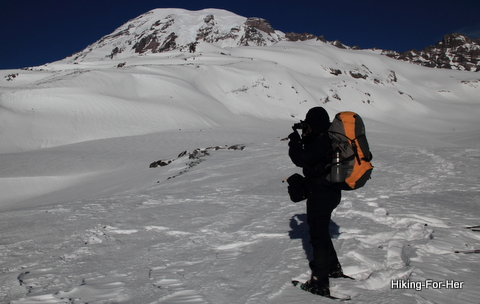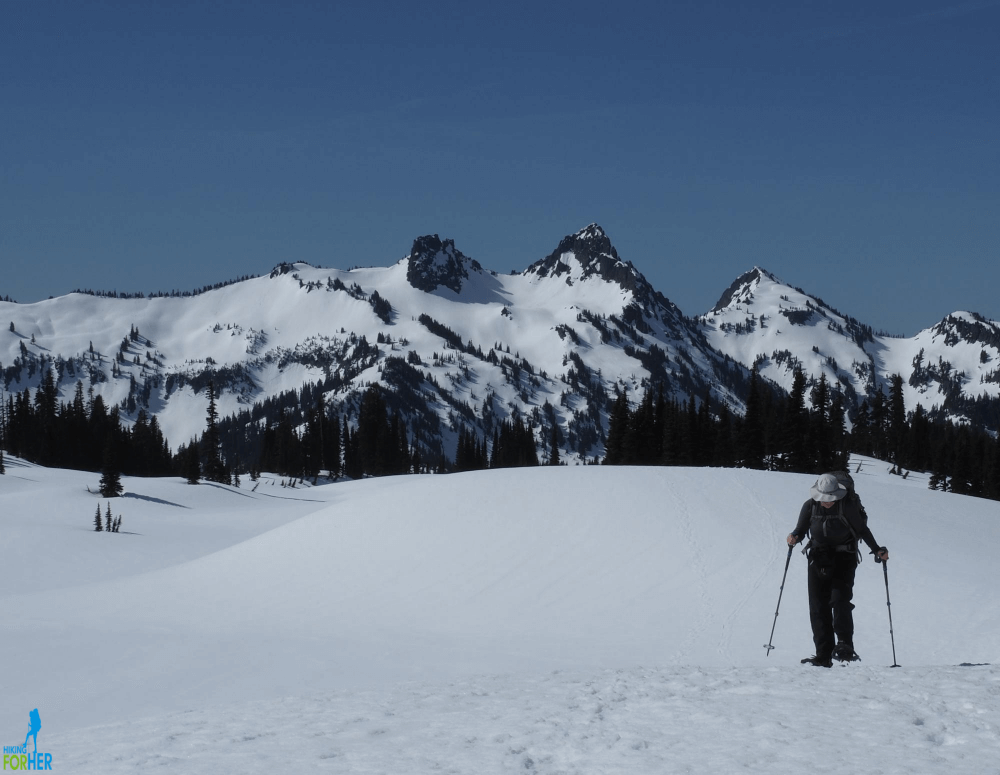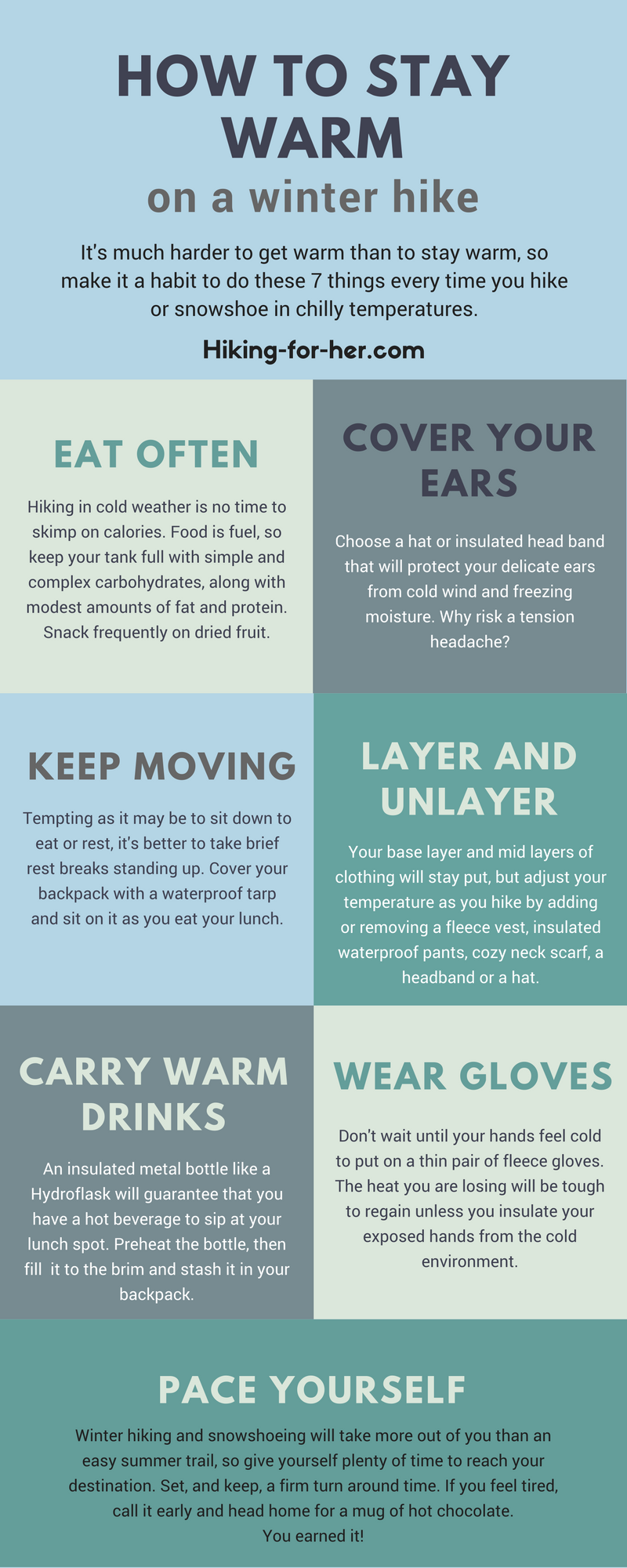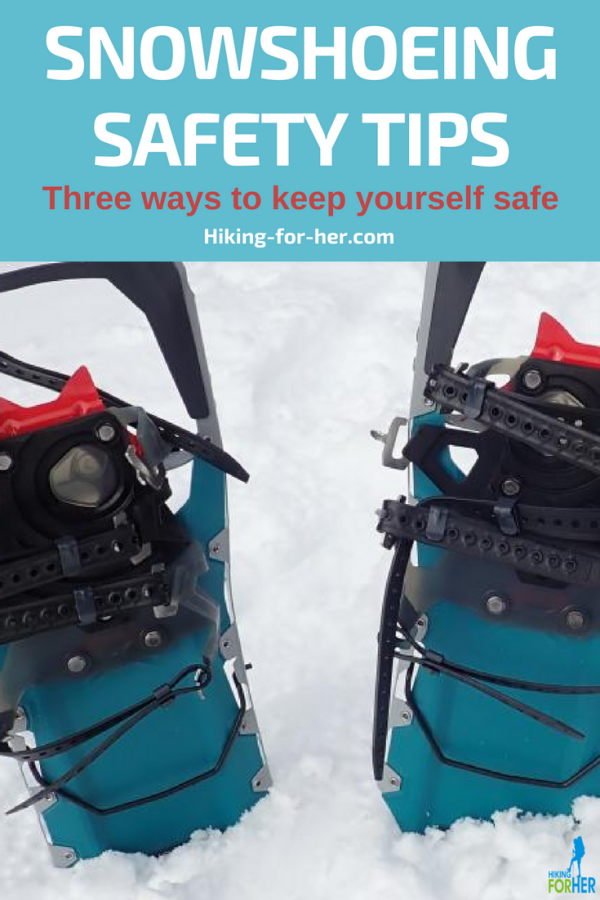
Best Safety Tips For Snowshoers
Including Resources
By Diane Spicer
You want the best safety tips for snowshoers, right?
Let's not waste another minute with a long winded introduction to snowshoeing.
Unless you want me to! Here are the beginner snowshoeing tips you need.
Ready for the best snowshoeing safety tips for women?
Here are all the details, in three part harmony:
- Planning for safe snowshoeing
- Being smart about snowshoeing safety
- Flexibility in your snowshoeing plans
Safety tips for snowshoers:
it's about planning
Of course we start with planning! It's the key to a safe snowshoe trip or any outdoor activity.
There are several things you've got to be on top of before you head out the door.
Failing to plan is planning to fail, as they say.
And for this vigorous winter sport, planning is your ticket to safety.
Especially if you're heading into mountainous backcountry!

Picking a destination for snowshoeing
Let's lump weather and location together, as they are interrelated.
Be proactive before you head out on your snowshoe adventure:
- Check the weather forecast for the exact area you're going to be in. It's important to acquire pinpoint accurate information as much as possible. Windy.org is a powerful resource to dial in your exact location
- If avalanche terrain is part of your plan, check that forecast as well. Use avalanche.org.
- The National Weather Service also has good resources with the ability to look at an exact area.
Gear and nutrition planning for snowshoers
Your body is your vehicle into the snowy wonderland, so treat it right.
Use Hiking For Her's snowshoe gear guide so you tax your body to the smallest extent possible. It's a vigorous workout, but the best snowshoeing gear can make it pleasurable - and safe.
Heed these snowshoeing food and drink tips. You want high calorie food for a snowshoe hike!
Now let's turn to the second major groups of safety tips for snowshoers.
Safety tips for snowshoers:
it's about using your smarts
You've got two things to be smart about:
- physical surroundings, including weather (mentioned above)
- group dynamics
 Lenticular clouds like these mean the weather is changing. Take heed!
Lenticular clouds like these mean the weather is changing. Take heed!
Be smart about terrain and weather
Winter hiking adds a brand new dimension to the joy of the trail.
It also adds new worries.
Examples: dealing with the cold and adjusting your pace to accommodate conditions.
- Dress in appropriate moisture wicking, insulating layers by using Hiking For Her's outdoor clothing layering guide.
- Pacing recommendations
And you will meet brand new hazards as a winter hiker:
- Tree wells that can trap (or even smother) you
- Icy stream crossings
- Unreliable snow bridges
- Snow covered rocks and logs that give way beneath your weight
Be especially alert for them as you move across the terrain.
If you have even a shred of doubt about your ability to surmount them, turn around.
There is no shame in knowing that you need a stronger outdoor skill set for snowshoeing.
Keep reading for tips on how to tackle that deficit.
Play it smart with human interactions
Every group has leaders, whether by overt agreement or tacit understanding.
If you're the leader, you have responsibility for pacing, destination, safety, and morale. Also:
- You've been on snowshoes many times before.
- You've got a plan up your sleeve for when things change, or don't work out.
- You've got a survival kit with you, and the Ten Essentials.
- You're carrying a communication device, either a personal locator beacon or a satellite messenger.
If you're following someone's lead, you've got responsibility for keeping up.
And speaking up.
I realize that you may have been raised to be seen and never heard.
Get over it!! Your voice is as important as anyone else's in the group.
- Not feeling great? Say so, and ask the leader to adjust the group pace.
- Energy level flagging? Ask for a snack break and sip some water to keep your stamina flowing.
Don't be a hero! Speak up
No matter your role, you've got to pay attention to the people who are snowshoeing in front of and behind you.
- If someone looks tired, cold, or otherwise not enjoying the day, speak up!
And not only that, you need to communicate clearly.
Ask for what you need.
Seek input from other group members about the right way to proceed.
Women seem more willing to talk about what's going on. Yet we are hesitant to inconvenience anyone.
Here's the deal:
If you have to be the one who brings up a problem, so be it.
It's better to talk it through as soon as it's noticed, than to ignore it until you can't ignore it any longer. That's when bad stuff happens.
A note about solo snowshoeing
While I have done this, I don't recommend it any longer.
Why not?
Short winter days.
Unpredictable weather patterns.
Thin margins for staying safe in the face of an error or injury.
Increased fatigue due to heavier winter gear.
Poor visibility in forested or foggy areas.
All these make me hesitant to recommend solo snowshoeing to anyone.
And with age, comes wisdom.
- Why take chances in the winter? is the mantra I use as a smart snowshoer.
For three season hiking, start with these solo hiking for women tips.
Now we move on to our third big group of safety tips for snowshoers.
Safety tips for snowshoers:
it's all about flexibility
Here's where most women shine: being able to change plans on the fly when it's clear that Plan A is not working out.
A few examples:
- The weather is changing fast: the route is becoming obscured, visual contact within the group is deteriorating, the temperature is plummeting.
- The terrain becomes more difficult than your map indicates. This is sometimes due to the scale of map you're using.
- A gear malfunction slowed down the group. But you came to the rescue with your gear repair kit!
I urge you to let go of the rigidity of a plan to make it to Location X, no matter what.
Don't let your trail companions talk you out of what you know, or feel, to be the right decision for you.
- When you're tired, the group, or part of it, should turn around. Never head back alone.
- When you have a gut feel that something is not right, talk it out.
- When conditions change to a less than favorable scenario, bail on the plan.
And when you just don't feel the snowshoeing love, you know what to do!
Resources for winter safety
beyond these safety tips for snowshoers
If you're going to be spending your day on snow, know how to approach it.
For example, if you're heading into steep terrain, learn the basics of avalanche safety.
Backcountry Babes runs courses and trips.
More of a do-it-yourself-er? Read this:
Another source of outdoor education for snowshoers: classes and events at REI Co-op.
- Check out what's available in your area.
- Co-op members receive discounts, so it's one smart reason to join. More reasons here.
Hiking For Her winter safety tips
Use the search box on this website to find exactly the topics on hiking safety you're interested in.
Here are a few links to get you started thinking about how to go into a wintery landscape and be home in time for dinner!
Snowshoeing is a blast!
 Silence and the snowshoes on your feet are the perfect recipe for a fantastic snowshoe hike!
Silence and the snowshoes on your feet are the perfect recipe for a fantastic snowshoe hike!"Blast" may not shout safety to you, but I'm confident you know what I mean.
The freedom of tromping over snow laden hills and valleys wearing snowshoes?
It is something you have to experience for yourself, at least once!
- By using these tips, you're way ahead of most folks who head out on snowshoes.
- Here are even more detailed snowshoe safety tips I've pulled together for you.
Relax and enjoy your snowshoe trips by heading out prepared, smart and flexible with these safety tips for snowshoers.
Yeehaw! Claim the freedom of snowshoes!
Save these for later on your Pinterest hiking board!
Home page > Snowshoeing Tips >
Best Safety Tips For Snowshoers
|
I get emails all the time about what I wear, eat, carry and love to use on the trail. That's
why I provide affiliate links to you: the best gear that I use myself and have seen used by other hikers is instantly
available for your consideration, and the gear company sends a few
pennies per dollar to this reader-supported hiking website. There is no added cost to you! Everyone ends up a winner: Great gear for you, strong gear companies, and more free hiking tips for everyone. Thanks very much for your support. It's warmly and sincerely appreciated. It also helps send these hiking tips to all your virtual trail buddies around the globe. |
 |



